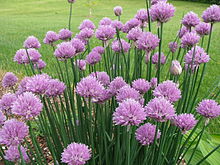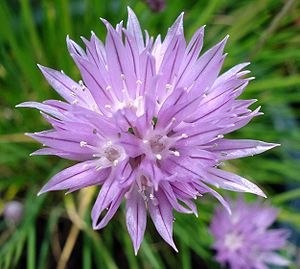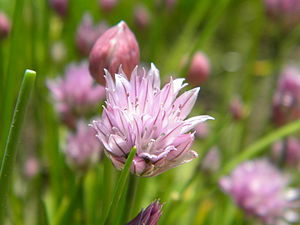 |
|
|
|
|
| Cuisines | Herbal | Spice | Curry | Yeast | Recipe | ||||||
|
Chives The chive (Allium schoenoprasum) is the smallest species of the edible onions. A perennial plant, it is native to Europe, Asia and North America. A. schoenoprasum is the only species of Allium native to both the New and the Old Worlds. The name of the species derives from the Greek skhoínos (sedge) and práson (leek). Its English name, chive, derives from the French word cive, from cepa, the Latin word for onion. Chives are a commonly used herb and can be found in grocery stores or grown in home gardens. In culinary use, the scapes are diced and used as an ingredient for fish, potatoes, soups, and other dishes. Chives have insect-repelling properties that can be used in gardens to control pests. Biology The chive is a bulb-forming herbaceous perennial plant, growing to 30–50 cm tall. The bulbs are slender, conical, 2–3 cm long and 1 cm broad, and grow in dense clusters from the roots. The scapes (or stems) are hollow and tubular, up to 50 cm long, and 2–3 mm in diameter, with a soft texture, although, prior to the emergence of a flower, they may appear stiffer than usual. The flowers are pale purple, and star-shaped with six petals, 1–2 cm wide, and produced in a dense inflorescence of 10-30 together; before opening, the inflorescence is surrounded by a papery bract. The seeds are produced in a small three-valved capsule, maturing in summer. The herb flowers from April to May in the southern parts of its habitat zones and in June in the northern parts. Chives are the only species of Allium native to both the Old World and the New World. Sometimes, the plants found in North America are classified as A. schoenoprasum var. sibiricum, although this is disputed. Differences among specimens are significant. One example was found in northern Maine growing solitary, instead of in clumps, also exhibiting dingy grey flowers. Although chives are repulsive to insects in general, due to their sulfur compounds, their flowers attract bees, and they are at times kept to increase desired insect life. Culinary arts Chives are grown for their leaves, which are used for culinary purposes as a flavoring herb, and provide a somewhat milder flavour than those of other Allium species. Chives have a wide variety of culinary uses, such as in traditional dishes in France and Sweden, among others. In his 1806 book Attempt at a Flora (Försök til en flora), Retzius describes how chives are used with pancakes, soups, fish and sandwiches. They are also an ingredient of the gräddfil sauce served with the traditional herring dish served at Swedish midsummer celebrations. The flowers may also be used to garnish dishes. In Poland, chives are served with quark cheese. Chives are one of the "fines herbes" of French cuisine, which also include tarragon, chervil and/or parsley. Chives can be found fresh at most markets year-round, making them readily available; they can also be dry-frozen without much impairment to the taste, giving home growers the opportunity to store large quantities harvested from their own gardens. Uses in plant cultivationRetzius also describes how farmers would plant chives between the rocks making up the borders of their flowerbeds, to keep the plants free from pests (such as Japanese beetles). The growing plant repels unwanted insect life, and the juice of the leaves can be used for the same purpose, as well as fighting fungal infections, mildew and scab. Its flowers are attractive to bees, which are important for gardens with an abundance of plants in need of pollination. MedicineThe medicinal properties of chives are similar to those of garlic, but weaker; the faint effects in comparison with garlic are probably the main reason for their limited use as a medicinal herb. Containing numerous organosulfur compounds such as allyl sulfides and alkyl sulfoxides, chives are reported to have a beneficial effect on the circulatory system. They also have mild stimulant, diuretic, and antiseptic properties. As chives are usually served in small amounts and never as the main dish, negative effects are rarely encountered, although digestive problems may occur following overconsumption. Chives are also rich in vitamins A and C, contain trace amounts of sulfur, and are rich in calcium and iron. CultivationChives are cultivated both for their culinary uses and their ornamental value; the violet flowers are often used in ornamental dry bouquets Chives thrive in well-drained soil, rich in organic matter, with a pH of 6-7 and full sun. They can be grown from seed and mature in summer, or early the following spring. Typically, chives need to be germinated at a temperature of 15 to 20°C (6-70°F) and kept moist. They can also be planted under a cloche or germinated indoors in cooler climates, then planted out later. After at least four weeks, the young shoots should be ready to be planted out. They are also easily propagated by division. In cold regions, chives die back to the underground bulbs in winter, with the new leaves appearing in early spring. Chives starting to look old can be cut back to about 2–5 cm. When harvesting, the needed number of stalks should be cut to the base. During the growing season, the plant will continually regrow leaves, allowing for a continuous harvest. |











